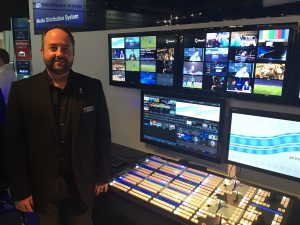NewTek’s IP Series Video-Production System Targets New Markets
The IBC is always an opportunity to witness company efforts in expanding their customer base. At IBC 2016, NewTek introduced the IP Series video-production system that merges next-generation IP technology with the old-school production-switcher interface that many technical directors are familiar with.
“In simple terms, we’re moving upmarket with this product in terms of both capacity and flexibility,” says Will Waters, product marketing manager, Newtek. “And it has the look and feel of control that operators are used to with software-defined live switching.”

NewTek’s Will Waters says the new IP Series will expand the company’s appeal to more mid-market and high-end production operations.
The IP Series, he adds, is a continuation and evolution of NewTek’s software-driven live production, something he says will give users the versatility to deliver the content they need.
“And, because it is modular,” he adds, “it can scale as necessary to meet needs. At the base level, we have a four-panel control surface tied to a single VMC1 Video Mix Engine that can bring up to 64 source channels.”
Those 64 source channels include 44 external inputs (each with key and fill) and full mixing control with 8M/E with full reentry, plus previz. Each Video Mix Engine includes integrated compositing, a sophisticated macro automation engine, and the most flexible and scalable effects system available, with almost unlimited matting, DVE, transitions, overlays, virtual sets, real-time data. and much more.
Multiple NewTek VMC1 Video Mix Engines can be placed on the network, allowing both expansion and full redundancy as needed to keep up with demands of any size of production. The base cost of the system with one Video Mix Engine is approximately $60,000.
“You can add more mix engines, and the control panel can drive multiple mix engines via Ethernet,” says Waters. “Each mix engine has a 72×8 internal router, so you are hard pressed to get to a creative limit.”
The NewTek VMC1 4S Control Panel is the tactile interface that connects the operator to single or multiple engines for precise control of the production. Paired with the VMC1 Video Mix Engine over a network, the control panel offers comprehensive functionality with four independently assignable stripes and premium hardware mechanics intuitively arranged and ergonomically designed to ensure optimal live performance.
The NewTek VMC1 IN Studio Input Module allows up to four SDI or IP inputs per module recognized by the NewTek VMC1 Video Mix Engine. Modules can be added at any location on the network to increase camera/source count as necessary. Adding new dimensions to production operations, each module includes a multiviewer with return video feed and capability to iso record to network storage.
“The Studio Input Module can be stacked and also gives a low-cost interface to bring in SDI or other IP sources,” says Waters.
He notes that a Studio Output Module will be available in a few months and will allow keying and other production requirements to be added as needed.
IP has been central to NewTek’s efforts in recent years, Waters says, as the company looks to take advantage of the IT developments in other industries.
“Those industries dwarf what we are doing,” he explains. “With more and more sports content being requested but budgets being constrained, [moving] to IP allows more niche events to be produced and more stories to be told [more economically].”
Although NDI is a proprietary NewTek IP format, the company is clearly open to other formats. According to Waters, an ASPEN card can allow ASPEN signals to become part of the NewTek workflow.
“Effectively,” he says, “any of our customers are going to look at this and amortize the costs over time. But, being software-defined, it is much more agile and flexible, and, because processing can be added, it fulfills the promise of future-proofing.”
